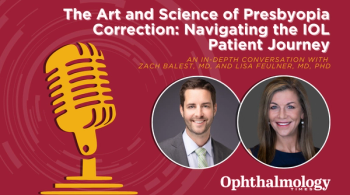
Study compares visual outcomes with femtosecond, mechanical microkeratomes
Washington, DC — Initial results from a prospective, parallel group comparison trial slightly favor use of the femtosecond microkeratome (IntraLase) compared with two mechanical microkeratomes for performing wavefront-guided LASIK.However, they point to no benefits when performing the procedures using a staged approach that takes into account the potential for flap creation to affect higher order aberrations compared with standard immediate ablation, reported David Tanzer, MD, at the American Society of Cataract and Refractive Surgery meeting.
April 17 - Washington, DC - Initial results from a prospective, parallel group comparison trial slightly favor use of the femtosecond microkeratome (IntraLase) compared with two mechanical microkeratomes for performing wavefront-guided LASIK.
However, they point to no benefits when performing the procedures using a staged approach that takes into account the potential for flap creation to affect higher-order aberrations compared with standard immediate ablation, reported David Tanzer, MD, at the American Society of Cataract and Refractive Surgery meeting.
The study is being conducted at the Naval Medical Center, San Diego. Patients underwent wavefront-guided LASIK using the VISX STAR S4 CustomVue (version 3.07) excimer laser after flap creation with the AMO Amadeus, Bausch & Lomb Hansatome, or IntraLase microkeratomes. Fifty patients in each microkeratome arm were randomized to undergo standard treatment with flap creation followed by immediate ablation and another 50 patients received a staged procedure in which the flap was cut, lifted, and laid back down, but the patient returned 4 weeks later for wavefront measurement and laser treatment.
Two surgeons-Dr. Tanzer and Steve Schallhorn, MD-performed all of the surgeries.Early clinical outcomes favored the femtosecond laser group. At 1 day, 1 week, and 1 month, the proportion of patients achieving 20/16 UCVA was significantly higher in patients with femtosecond laser-created flaps compared with the mechanical microkeratome groups. At 3 months, the UCVA and MSE outcomes were similar in all groups, but a significantly higher proportion of patients in the femtosecond laser group gained 1 line of BCVA, and results of mesopic contrast acuity testing also favored the femtosecond laser.
Considering eyes that received a staged procedure, there was a slight reduction in higher-order aberrations after 1 month in the femtosecond group and slight induction in both mechanical microkeratome groups. However, comparisons between standard and staged treatment groups within each microkeratome arm showed no statistically significant benefits for staging the procedure with respect to visual, refractive, or predictability outcomes.
"Currently, Navy aviators can only receive PRK. With consideration being given to the possibility of performing LASIK, this study is being conducted to evaluate the best flap technology for flap creation and whether better outcomes can be achieved with a staged approach that takes into account flap creation-induced higher-order aberrations," Dr. Tanzer said.
"So far, there appear to be some benefits for the femtosecond laser, but not for the staged approach. However, this is the first time this dataset has been reported, the results must be considered preliminary, and we will be analyzing other important endpoints," he concluded.
Newsletter
Don’t miss out—get Ophthalmology Times updates on the latest clinical advancements and expert interviews, straight to your inbox.


















































.png)


